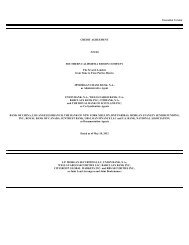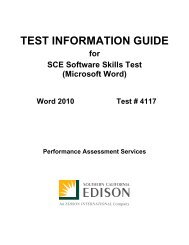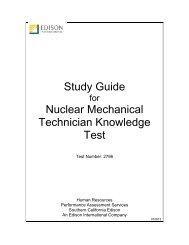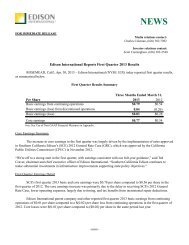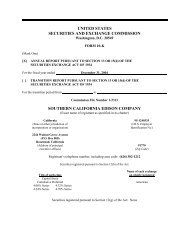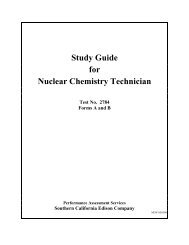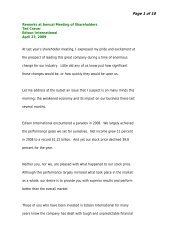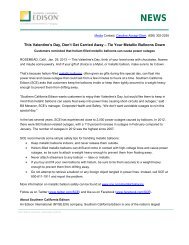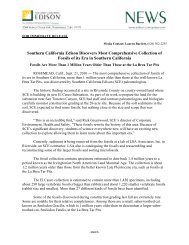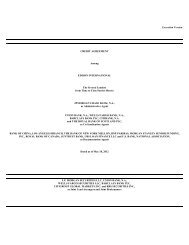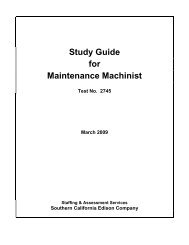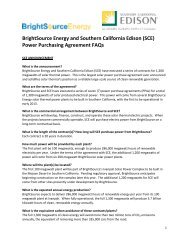10-Q - Edison International
10-Q - Edison International
10-Q - Edison International
You also want an ePaper? Increase the reach of your titles
YUMPU automatically turns print PDFs into web optimized ePapers that Google loves.
The following table sets forth a summary of changes in the fair value of Level 3 net derivative assets and liabilities:March 31,(in millions) 2012 2011Fair value of net assets (liabilities) at beginning of period $ (754) $ 6Total realized/unrealized (losses), net:Included in regulatory assets 1 (356) (134)Purchases 21 —Settlements (8) 1Transfers into Level 3 — —Transfers out of Level 3 — —Fair value of net liabilities at end of period $ (1,097) $ (127)Change during the period in unrealized losses related to assets and liabilitiesheld at the end of the period $ (351) $ (133)1Due to regulatory mechanisms, SCE's realized and unrealized gains and losses are recorded as regulatory assets and liabilities.The fair value for transfers in and transfers out of each level is determined at the end of each reporting period. There were notransfers between Levels 1 and 2 during 2012 and 2011.Valuation Techniques Used to Determine Fair ValueLevel 1The fair value of Level 1 assets and liabilities is determined using unadjusted quoted prices in active markets that areavailable at the measurement date for identical assets and liabilities. This level includes exchange-traded equity securities andderivatives, U.S. treasury securities and money market funds.Level 2The fair value of Level 2 assets and liabilities is determined using the income approach by obtaining quoted prices for similarassets and liabilities in active markets and inputs that are observable, either directly or indirectly, for substantially the fullterm of the instrument. This level includes fixed-income securities and over-the-counter derivatives. For further discussion onfixed-income securities, see "—Nuclear Decommissioning Trusts" below.Over-the-counter derivative contracts are valued using standard pricing models to determine the net present value ofestimated future cash flows. Inputs to the pricing models include forward published or posted clearing prices from exchanges(New York Mercantile Exchange and Intercontinental Exchange) for similar instruments and discount rates. A primary pricesource that best represents trade activity for each market is used to develop observable forward market prices in determiningthe fair value of these positions. Broker quotes, prices from exchanges or comparison to executed trades are used to validateand corroborate the primary price source. These price quotations reflect mid-market prices (average of bid and ask) and areobtained from sources believed to provide the most liquid market for the commodity.Level 3The fair value of Level 3 assets and liabilities is determined using the income approach through various models andtechniques that require significant unobservable inputs. This level includes over-the-counter options, tolling arrangementsand derivative contracts that trade infrequently such as congestion revenue rights ("CRRs") and long-term power agreements.Assumptions are made in order to value derivative contracts in which observable inputs are not available. Changes in fairvalue are based on changes to forward market prices, including extrapolation of short-term observable inputs into forecastedprices for illiquid forward periods. In circumstances where fair value cannot be verified with observable market transactions,it is possible that a different valuation model could produce a materially different estimate of fair value. Modelingmethodologies, inputs and techniques are reviewed and assessed as markets continue to develop and more pricinginformation becomes available and the fair value is adjusted when it is concluded that a change in inputs or techniques wouldresult in a new valuation that better reflects the fair value of those derivative contracts.Level 3 Valuation ProcessThe process of determining fair value is the responsibility of the risk department which reports to the chief financial officer.This department obtains observable and unobservable inputs through broker quotes, exchanges and internal valuation<strong>10</strong>



